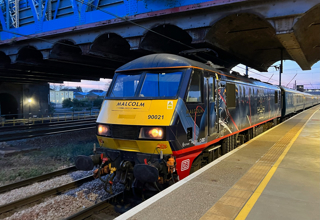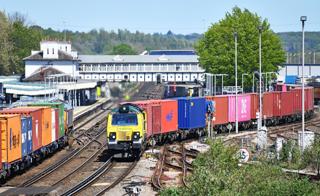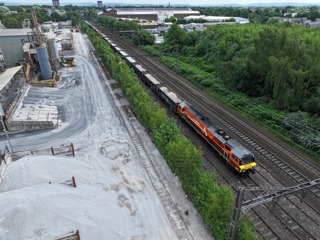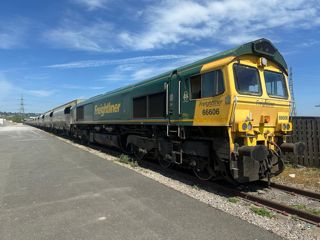
The first Class 67 has been scrapped only 26 years after it was delivered the UK.

The first Class 67 has been scrapped only 26 years after it was delivered the UK.
67003 was taken to Kingsbury in late May having been out of traffic since 2019.
The 30 locomotives were ordered in the late 1990s with the intention of running at postal trains at 125mph. However contracts with Royal Mail ended within five years of their arrival.
Since then EWS, and latterly DB Cargo UK, has been been looking for ways to use them.
Back in September 1999 RAIL was invited to Alstom's Valencia factory and test track where the '67s' were being built. Here's the report of that visit which was published in October 1999, and what their intended use.
--
First EWS Class 67 ready for delivery within days
EWS is expecting to take delivery of the first of its General Motors Class 67s in the middle of this month - and ten should be in traffic by December 1.
The 30 Class 67 Bo-Bo locomotives arc being built under licence by Alstom at Valencia, Spain, where the body shell of 67019 has already been constructed.
As RAIL closed for press, plans were being drawn up to send 67003 to a port near Valencia on September 29 for loading on to a ‘Jumboship’ for delivery to Newport, South Wales.
Currently 67002 is undergoing extensive testing on the new high-speed AVE line at La Sagra, where it has already reached speeds of up to 115mph.
Once in traffic, the locomotives will be passed for 125mph running.
By late September, 67003 and 67004 had undergone testing at Valencia, while 67001 had completed initial static testing and was being prepared for fitting with its two four-wheel bogies. In the paintshop was 67005 while 67006 was being prepared for painting. The bodies of 67007-017 were in various stages of being fitted out internally, while the raw metal bodies of 67018-019 were welded into shape. Cabs and bodyside parts for 67020-023 were in the workshops.
Arrival of the Class 67s will spell the end for elderly and increasingly unreliable Res Class 47s.
The first will be put to use on Res trains from Willesden Railnet to Plymouth and Cardiff allowing their 125mph capability to be exploited.
Delivery of the last ‘67’ is expected early next year and when the entire fleet is in traffic it will be used on the North East/South West line from Newcastle to Penzance, as well as to Swansea.
Their greater reliability and need for less time for routine maintenance, combined with their faster top speed, means the 30 Class 67s will be able to replace virtually all EWSR’s current fleet of 57 Class 47/7-s and eight Class 47/4s still in daily use on Res trains. However, some diagrams will still need Class 47s - such as ScotRail ‘sleepers’ Class 47/7.S with reliability improvements (in the WTIDM pool) could remain in traffic slightly longer.
--
Royal Mail by rail at 125mph!

Class 67s will work first from Willesden Railnet to Plymouth and Cardiff and later Penzance and Swansea.
After that, they will work to Low Fell (Newcastle) from the West Country.
EWS says there will be few places where ‘67s’ can run at 125mph because of line speed restrictions. However, the ‘67s’ will save time both in acceleration and in areas where speeds more than the 95mph of a Res ‘47’ can be achieved, such as the ECML and GWML .
As well as Res duties, the Class 67s will also carry out charter work - duties ideally suited for locomotives with their ETS and 125mph capability.
Although designed specifically for the Res sector, the Class 67 is perfectly capable of working freights, and there is no reason to suggest they won’t do so. ‘67s’ are equipped with the slow speed control system as fitted to a ‘66’ - allowing settings of 0-10mph in 0.2mph increments. However, because of the ‘67’s’ high top speed, gearing is high so the starting tractive effort is not particularly great. This means the locomotives will struggle if starting a heavy' train, especially on a gradient or greasy rails. However, such is EWSR’s common-user policy that if the business calls for a spare ‘67’ to work freight, then it will.
The locomotives are likely to be allocated to Cardiff although, like the ‘66s’, they will be common-user, so depot allocation is purely for computer records.
A major reason for buying the ‘67s’ was quite simply that the ‘47s’ have had their day. The price of achieving any kind of acceptable reliability and cost-effectiveness for the Class 47 fleet would be prohibitive. It was far more cost-effective to buy new, and EWS can replace more ‘47s’ with fewer ‘67s’ because of greater use and availability. EWS is looking at regular 95% availability for the ‘67s’ compared with 75% for the ‘47s’.
Major cost savings will result from better maintenance cycles. On a ‘67’, these will be far less onerous - the locomotive will have a 120-day cycle for each A-exam, resulting in much less time in the workshop. The maintenance cycle is based on the power unit which will need regular attention throughout the locomotive’s life. Any day-to-day running faults will be identified at visual checks during fuelling and drivers’ fault log books.
When the ‘67s’ enter traffic, they will start with a 90 calendar-day A-cxam schedule, but this will quickly move on to a 120 day A-cxam cycle. The exam schedule is accumulative; each locomotive will also have a 320- day and a yearly exam. EWS plans to build a definitive maintenance cycle for the fleet. Generally, calendar dayswill equate to working days, allowing better planning.

EWS has not yet devised an exact plan for major overhauls as there is time to develop maintenance procedure as locomotives settle in to traffic. The company doesn’t see the ‘67’ as being too much different from a ‘66’ on maintenance. Mileages will be higher because of the higher speeds, but that doesn’t affect the power unit because the loads are lighter.
EWS expects to be looking at power unit attention after between six and eight years, with a major overhaul vision of between 12 and 16 years. Major engineering will probably be at Toton, as with other EWS fleets.
Fuel consumption should be better than a ‘47’s’ because the power unit is more modern. Efficiency is better, particularly at high speed. The locomotives will be also cheaper to run than a ‘47’, which uses more coolant and oil. This doesn’t happen with the GM power unit. The real savings for the ‘67s’ are in the maintenance cycle, with increased use between exams meaning less spent on parts and labour. These cheaper operational costs over the lifetime of the fleet should run into millions of pounds.
Conclusions
The ‘67’ is a magnificent locomotive, and its benefits - significantly superior availability and cheaper operating costs - will revolutionise EWSR’s Res operation. Like the Class 66, the ‘67’ is further proof of the excellent GM product, and a glowing testament to why EWS has opted for American locomotives. The life expectancy of a ‘67’ is 40 years. All components are changeable and consumable, and body rust is not considered an issue.
They look like having a long time on Britain’s railway.
Login to continue reading
Or register with RAIL to keep up-to-date with the latest news, insight and opinion.

















Login to comment
Comments
No comments have been made yet.